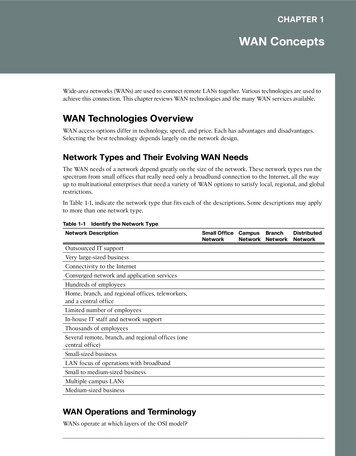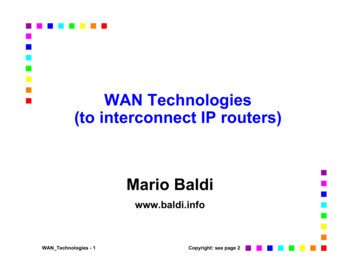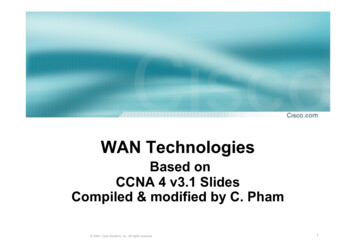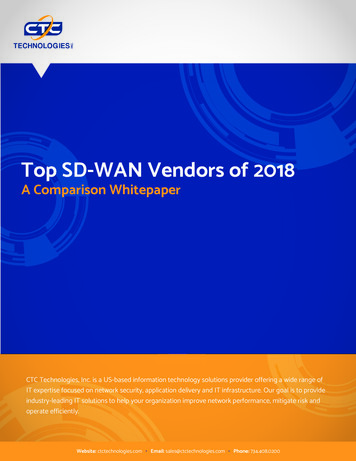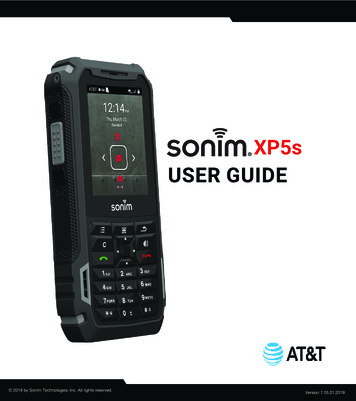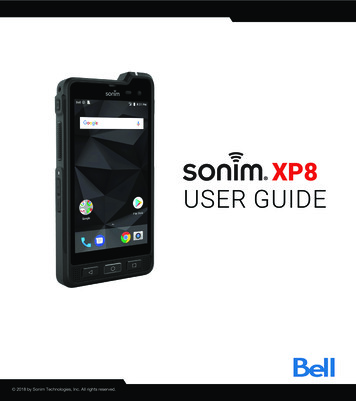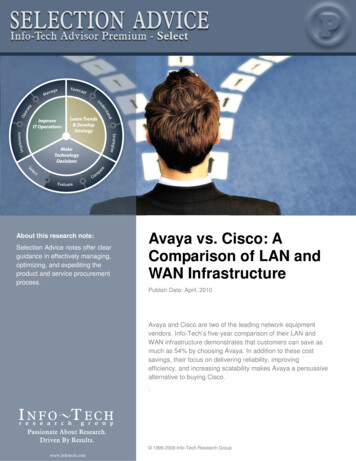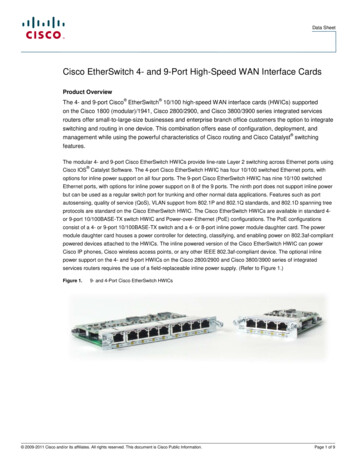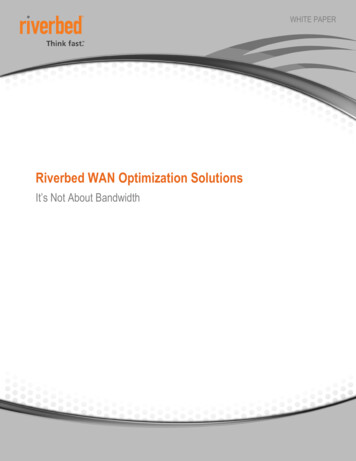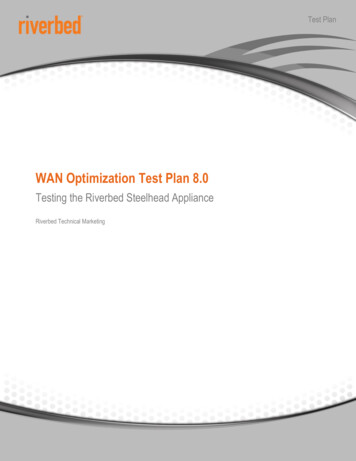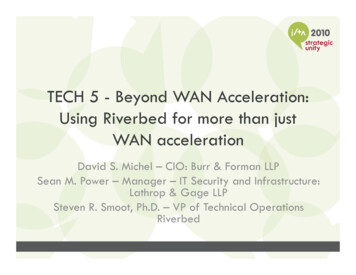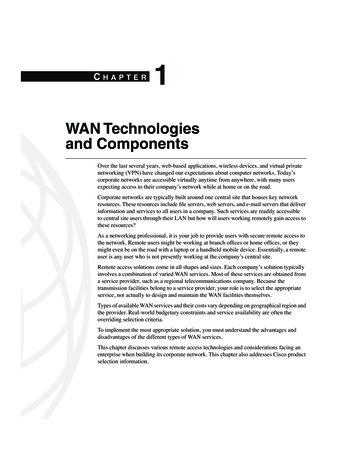
Transcription
1486fmF.book Page 3 Tuesday, January 13, 2004 8:16 AMCHAPTER1WAN Technologiesand ComponentsOver the last several years, web-based applications, wireless devices, and virtual privatenetworking (VPN) have changed our expectations about computer networks. Today’scorporate networks are accessible virtually anytime from anywhere, with many usersexpecting access to their company’s network while at home or on the road.Corporate networks are typically built around one central site that houses key networkresources. These resources include file servers, web servers, and e-mail servers that deliverinformation and services to all users in a company. Such services are readily accessibleto central site users through their LAN but how will users working remotely gain access tothese resources?As a networking professional, it is your job to provide users with secure remote access tothe network. Remote users might be working at branch offices or home offices, or theymight even be on the road with a laptop or a handheld mobile device. Essentially, a remoteuser is any user who is not presently working at the company’s central site.Remote access solutions come in all shapes and sizes. Each company’s solution typicallyinvolves a combination of varied WAN services. Most of these services are obtained froma service provider, such as a regional telecommunications company. Because thetransmission facilities belong to a service provider, your role is to select the appropriateservice, not actually to design and maintain the WAN facilities themselves.Types of available WAN services and their costs vary depending on geographical region andthe provider. Real-world budgetary constraints and service availability are often theoverriding selection criteria.To implement the most appropriate solution, you must understand the advantages anddisadvantages of the different types of WAN services.This chapter discusses various remote access technologies and considerations facing anenterprise when building its corporate network. This chapter also addresses Cisco productselection information.
1486fmF.book Page 4 Tuesday, January 13, 2004 8:16 AM4Chapter 1: WAN Technologies and ComponentsWAN Connection CharacteristicsMany significant WAN connection characteristics can be grouped into the followingcategories: Connection durationDedicated— Always on.— Cost is typically related to bandwidth and distance.On demand— Connected on demand.— Cost related to time of usage and bandwidth and distance. SwitchingCircuit switched— End-to-end bandwidth allocation and control.— Provisioned permanently or on demand.Packet switched— Asynchronous Transport Network (ATM).— Statistical bandwidth allocation in transport network.— Cost typically related to bandwidth guarantee and other quality of service(QoS) parameters. Synchronization mechanismExternal— Clocking determined by a separate conductor in the media.— Thicker cable with more conductors per connection.Embedded— Clocking determined by bit times within the data stream.— Fewer conductors per connection. Data rateNarrowband— Rates up to and including 128 kbps (Example: dialup).Broadband— Data rates greater than narrowband rates. (The exact dividing line involvesmore marketing than technology. Broadband is greater than ISDN BasicRate Interface [BRI] and equal to or less than T3 line example: cablemodem.)
1486fmF.book Page 5 Tuesday, January 13, 2004 8:16 AMCommon WAN Connection Types TerminationEnd-to-end circuits— Bit synchronization and data link termination is managed at the ends of thecircuit, giving an appearance of increased control. The service provider istransparent.Transport network— The intermediate network terminates bit synchronization; content is carriedasynchronously across the transport network. Includes packet switchingFrame Relay (FR) and ATM and broadband access technologies. Transmission mediaCopper: Cheaper for lower data rates and shorter distances— Twisted pair.— Coaxial cable.Fiber: Carrier for high data rates and longer distances Multimode.Single mode.Table 1-1 provides a list and comparison of various WAN connection characteristics.Table 1-1WAN Connection CharacteristicsConnection DurationDedicatedOn lEmbeddedData ort networkMediaCopper- Twisted pair- CoaxialFiber- Multimode- Single modeCommon WAN Connection TypesFor the purpose of this discussion, WAN connections have been grouped in four generalcategories, which reflect generally available WAN services: Dedicated circuited switchedOn-Demand circuit switchedPacket-switched virtual circuitBroadband access5
1486fmF.book Page 6 Tuesday, January 13, 2004 8:16 AM6Chapter 1: WAN Technologies and ComponentsDedicated Circuit Switched-ConnectionsLeased line serial connections typically connect to a transport service provider througha data communications equipment (DCE) device, which both provides a clock andtransforms the signal to the channelized format used in the service provider network. Thesepoint-to-point dedicated links provide a single, pre-established WAN communications pathfrom the customer premises, circuit switched through a carrier network, to a remotenetwork. Dedicated lines through T3/E3 rates are frequently described as leased lines. Theestablished path is permanent and fixed for each remote network reached through thecarrier facilities. The service provider reserves the private use of the customer circuitsthrough the transport network full time.Synchronization of the timing and data-link control is preserved end to end. Thesededicated connections are made using the synchronous serial ports on the router withbandwidth use of up to 34 Mbps over a service provider E3 transport link and 45 Mbps overT3. Different encapsulation methods at the data link layer provide flexibility and reliabilityfor user traffic. Typical connections on a dedicated network WAN connection employ 56kbps, 64 kbps, T1, E1, T3, and E3 data rates.The following synchronous serial standards are supported on Cisco routers through serialinterfaces: Electronic Industries Association/Telecommunications Industry Association (EIA/TIA)-232 EIA/TIA-449V.35 (48 kbps)EIA/TIA-530X.21 (2 Mbps)In North America the connecting device is called a channel service unit/data service unit(CSU/DSU), as shown in Figure 1-1. The CSU connects to the service provider network,while the DSU connects to the network device serial interface. It is a device (or sometimestwo separate digital devices) that adapts the media format from a serial data terminalequipment (DTE) device, such as a router, to the media format of the service providerequipment, such as a WAN switch, in a switched carrier network. The CSU/DSU alsoprovides signal clocking for synchronization between these devices. Figure 1-1 shows theplacement of the CSU/DSU.It is increasingly common to have direct connections to the carrier transport network usingfractional or complete T1/E1 circuits. In this case, a CSU provides demarcation and logicaltermination between the service provider network and the customer network. Direct T3/E3and SONET/SDH (Synchronous Optical NETwork/Synchronous Digital Hierarchy)connectivity might also be available for organizations requiring higher data rates.
1486fmF.book Page 7 Tuesday, January 13, 2004 8:16 AMCommon WAN Connection TypesFigure 1-17Dedicated Circuit-Switched-ConnectionsLeased LinesEIA/TIA-232, EIA/TIA-449,V.35, X.21, EIA/TIA-530DSU CSUCSU DSUTDM CircuitsDS0 to T1/E1 Through T3/E3CSU Often in InterfaceCSUCSUThe private nature of a dedicated connection allows a corporation better control over theWAN connection. Dedicated connections also offer high speeds beyond T3/E3 levels usingSONET/SDH. Dedicated connections are ideal for high-volume environments with steadyrate traffic patterns or high peak demands of critical traffic. However, because the line is notshared, dedicated connections tend to be more costly.As a general rule, dedicated connections are most cost-effective in the following situations: Long connect timesShort distancesCritical traffic requirements that must be guaranteedOn-Demand Circuit-Switched ConnectionsOn-demand circuit switching is a WAN transport method in which a dedicated physicalcircuit through a Public Switched Telephone Network (PSTN) is established, maintained,and terminated for each communication session, as shown in Figure 1-2. Initial signalingat the setup stage determines the endpoints and the connection between the two endpoints.
1486fmF.book Page 8 Tuesday, January 13, 2004 8:16 AM8Chapter 1: WAN Technologies and ComponentsFigure 1-2On-Demand Circuit-Switched ConnectionsFileServerPSTNDial AccessISDNPOTSE-MailServerTypical circuit-switched connections are as follows: Asynchronous modemISDN Basic Rate Interface (BRI) and ISDN Primary Rate Interface (PRI)Advantages of on-demand connection types include dynamic selection of the circuitendpoint, and the accumulation of charges for transport while only connections are active.Costs are directly related to connection time and distance for each POTS line or ISDNbearer channel. As traffic between endpoints increases in volume, the duration of theconnection increases.Asynchronous Modem ConnectionsAsynchronous modem connections require minimal equipment cost and use the existingtelephone network. Users can easily access a central site from any location that has atelephone connection into a telephone network.The nature of asynchronous connections allows you to configure your connection to beenabled only when you need the service by using dial-on-demand routing (DDR) throughthe modem using an asynchronous serial interface. DDR is ideal when you need only shortterm access.Enable DDR on your asynchronous interface when the following is true: Traffic patterns are low-volume or periodic—Calls are placed and connections areestablished only when the router detects traffic marked as “interesting.” Periodicbroadcasts, such as routing protocol updates, should be prevented from triggering acall. You need a backup connection for redundancy or load sharing—DDR can be usedto provide backup load sharing and interface failure backup.
1486fmF.book Page 9 Tuesday, January 13, 2004 8:16 AMCommon WAN Connection Types9A router acts as a network access server, which is a concentration point for dial-in and dialout calls. Mobile users, for example, can call in to an access server at a central site to accesstheir e-mail messages.Asynchronous connections are useful in the following situations: A backup connection is required.You have a small site.Short-term on-demand access is needed.Periods of lower network traffic and fewer users. Depending on network size, thisnumber is generally 18 percent or below. This percentage has become a practical, lowvolume standard in networks at most organizations.Asynchronous connections through the PSTN require modems at each end of theconnection to convert digital data signals to analog signals that can be transported over thetelephone network. Modem speeds typically vary from 19.2 kbps to 56 kbps depending online quality. The slower bandwidth speeds limit the amount of traffic you might want tosend over an asynchronous line. To place or receive an asynchronous serial call, set up aCisco router with an asynchronous serial interface. The serial standard to attach to anexternal modem is EIA/TIA-232. The interface to the telephone company varies by country.In the United States, a standard RJ-11 adapter connects the modem to the telephone outlet.ISDN ConnectionsIntegrated Services Digital Network (ISDN) connections are typically switchedconnections that, like asynchronous connections, provide WAN access when needed ratherthan requiring a dedicated link. ISDN offers increased bandwidth over a typical dial-upconnection, faster setup, and is intended to carry data, voice, and video traffic across atelephone network.To place an ISDN BRI call, you should set up your router with a BRI interface, as shownin Figure 1-3, or an ISDN terminal adapter, which is a device used to connect ISDN BRIconnections to other interfaces such as EIA/TIA-232. A terminal adapter is essentially anISDN modem. You should also consult your telephone company for information specific toyour connection.Figure 1-3ISDN ConnectionsBRI 2.048/1.544NT1SwitchPRI 128 KT1 23 B DE1 30 B DISDNServiceProvider
1486fmF.book Page 10 Tuesday, January 13, 2004 8:16 AM10Chapter 1: WAN Technologies and ComponentsNOTEGenerally, in Europe, the service provider supplies the Network Termination 1 (NT-1). InNorth America, the customer supplies the NT-1.ISDN PRI is configured over connections such as T1 and E1 technologies. T1 is used inNorth America, and E1 is common in other countries. To place an ISDN call, set up yourrouter with the proper connection.As with asynchronous connections, you can also configure DDR to control access forspecific periods of time.Packet-Switched Virtual ConnectionsPacket switching is a method in which a network device uses a single point-to-point link toa service provider to transport packets intended for one or more destinations across a carriernetwork, as shown in Figure 1-4. Packet switching is a networking technology based on thetransmission of data in packets. Dividing a continuous stream of data into small units(packets) enables data from one or more sources to one or more destinations to share thecommunication channels within the transport network.Figure 1-4Packet-Switched Connections Virtual circuits are established. Packet-switched networks generally sharebandwidth statistically.Packet-switched networks use virtual circuits (VCs) that provide end-to-end connectivity.Statically programmed switching devices accomplish physical connections. Packet headersidentify the circuit, and the headers might change on each network link traversed. Itrequires the use of precise switching information throughout the transport network.Packet-switched network
— The intermediate network terminates bit synchronization; content is carried asynchronously across the transport network. Includes packet switching Frame Relay (FR) and ATM and broadband access technologies. Transmission media Copper: Cheaper for lower data rates and shorter distances —Twisted pair. — Coaxial cable.
